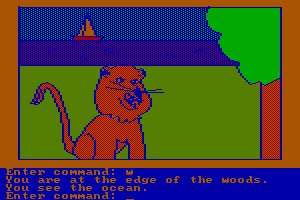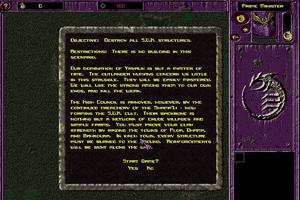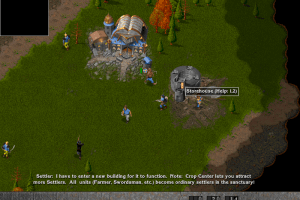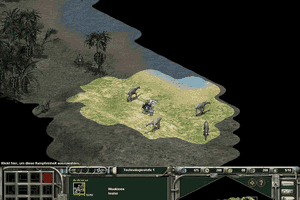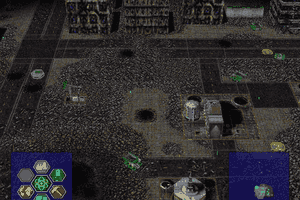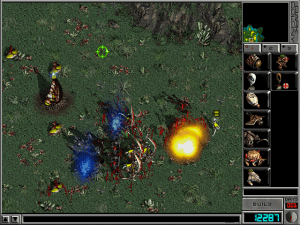Submarine Titans
Windows - 2000
Description of Submarine Titans
Voyage to the bottom of the Sea
After some initial confusion regarding release and distribution, Submarine Titans has now shipped in North America. The title has been developed by Adelaide-based Ellipse Studios, formerly Megamedia. The core of this small team upped and left their native Ukraine for Australia to release Ancient Conquest, a Greek mythology title which looks interesting enough but seems to have fallen into relative obscurity. For Submarine Titans, their second release, Ellipsesigned a publishing deal with Strategy First, the developer/publishing outfit responsible for Disciples: Sacred Land and the less memorable Clans and Man of War series.
When I previewed Submarine Titans last month, I was impressed with the demo. You could say it wet my appetite (excuse the pun). Whilst a nautical theme has been used extensively before now, the focus has tended to be on simulations like Silent Hunter and the Harpoon series or surface engagements like Fleet Command and Age of Sail. I find it surprising that no one has thought of using the deep ocean as the setting for a RTS game before now, particularly when you consider the popularity of legends such as Atlantis. Perhaps one of the reasons is the relative limitation of the aquatic setting in comparison to a surface environment where land, sea and air can be featured. My one major concern with the demo was that this could turn out to limit the game's replayability. Having now reviewed a gold master I have to say that this concern has been realised. However, despite a few weaknesses, Submarine Titans has plenty to offer RTS fans.
Ellipse has provided a detailed chronological list of events leading up to 2115, the current setting for the game. In summary, following a comet strike in 2047, the surface of the planet has been rendered largely uninhabitable. The rapid heating effect has caused the polar regions to melt, raising the sea level by sixty feet. Because of the relative protection offered by the deep ocean, the few remaining survivors have rebuilt their civilisations in submerged installations. Two rival factions have arisen, the White Sharks, anxious to regain a position of world dominance and the Black Octopi, seeking balance with the earth and prepared to enforce it with all the weapons at their disposal. To make things more interesting, an alien race of creatures, the Silicons, seem to have hitched a ride on the comet and are hell bent on causing mayhem. As you'd expect, there are a lot of similarities between the human factions whereas the iridescent Silicons are more organic, reminiscent of the aliens from The Abyss. In practice, the majority of this story background is superfluous and will be of limited interest. Whether it is intended or not, I found Submarine Titans to be a fun title and consequently, it is difficult to take any of the background story seriously. Providing such a detailed chronological sequence of events for the game does provide a sense of history but doesn't add any real depth (I can see I'm going to have a problem with some reserved words). The game comes complete with three story-driven faction campaigns, each of ten missions; a battle (or skirmish) mode; multiplayer mode; and a comprehensive mission editor for producing standalone missions or creating custom campaigns, rather confusingly referred to as Add-Ons. Campaign play is a linear affair with mission briefings delivered by a combination of text display and narration. Although these are story-based, they tend to result in fairly unimaginative objectives like, 'seek and destroy' and 'escort this artefact/resource from A to B'. Some are time bound and once you start the mission additional instructions are given, not always particularly clear. There is often a presumption that you know what is going on before you get the briefing and as a lesser point, the use of English grammar sometimes leaves a great deal to be desired. After every three or so missions, there is an eye candy treat in the form of a cut scene. Whilst visually impressive, these tend to reflect a far more sinister atmosphere than the game itself. I'm not sure if my review copy has all of the cut scenes as I have seen still shots of characters who don't appear in any of those I've viewed. The most exciting sequence of all is the opening movie which succeeds in grabbing your attention.
Run Silent, Run Deep
There are twenty-three pre-defined skirmish maps on the gold master, including ten multiplayer. You can adjust the default settings for starting team resource levels, the entry and ceiling technology tree levels, unit limit, AI opponent and team settings, and the initial object set (three faction-specific presets ranging from a single construction unit to up to eight submarines). Alternatively, you can generate a random map in much the same way as you would in Age of Empires. This approach allows you to customise some additional settings, including map size, resource abundance, mountain density, and terrain type (arctic, mediterranean, tropical, or toxic). Three game types are catered for; Kill All, Kill All without materials, and The Flagship Hunt.
20,000 Leagues Under the Sea
There are six resources used in the game and, in time-honoured RTS fashion, each is mined and harvested. Typically, this revolves around the positioning of an extractor facility over a resource deposit. Cargo subs are then used to transport the material to a silo structure. The human factions use four resources; metal to build units and structures; corium (an immensely powerful resource found in comet fragments) to power units, structures and weapons; gold to fund research; and oxygen for the underwater colony life-support systems. The allocation of oxygen can be prioritised across building, the submarines themselves, research, repair, and weapons energy. The Silicons use just three resources; silicon to build units and structures; corium to arm weapons; and energy to regenerate. In a similar way to Age of Kings, you can buy and trade gold, corium and metal using a trade centre or market structure. The extraction and trading of these resources is fundamental to the game. The trick is to balance your base development with military expansion. This is best achieved by building sufficient structures to support your submarine squadrons and by keeping on top of technology developments.
The game features no less than 38 submarines. These perform a wide variety of tasks including construction, transport, repair, reconnaissance, minelaying, sabotage, and shield generation. Whilst not as apparent as in Shogun or Dark Reign 2, a scissors/paper/rock concept is present. Units such as the White Shark Psychotron are able to disorientate enemy submarines and force them to turn on their own comrades. The Silicon Paralysis Probe can disable enemy units for a limited time and the Usurper can capture submarines and structures (this can be useful if an opponent has developed a particularly powerful object, though once the units ammunition has been exhausted, it is of little subsequent use). Not at all in keeping with their ecological ideology and certainly not politically correct is the Black Octopi's Cyberdolphin. This unit is a specially bred hybrid creature that can carry a powerful charge that can destroy or seriously damage enemy submarines. But fear not animal lovers, Cyberdolphins are almost invulnerable thanks to their great speed and manoeuvrability. Other interesting units include Vermin, Bio-Acid Assaulters, and the stealth focused Phantom. In general terms, the White Sharks rely on numbers over technology whereas the Black Octopi favour technological development. The Silcons are the most balanced of the three factions and tend to have the most elaborate units and structures.
Hostile Waters
Your submarines are built and maintained by a total of 72 structures across the three factions. These are divided into several categories, e.g. basic, supply, defensive, and special. Again, there are unique faction characteristics. The White Sharks can use the Teleshield to block Black Octopi Teleporter assaults (a structure which allows them to cross units instantaneously across large distances). For their part, the Black Octopi can mask their submarines by keeping the close to an Anti-Sonar Shield. The Silicons don't miss out on the fun either, with a an Ion Field Generator to limit damage to nearby units and structures by half and a Gas Laser Satellite Launcher, or GLS, to destroy strategic targets from space. Typically, each faction has about six unique structures though even the common ones differ slightly in appearance and performance. Extensive technology trees are ascended by means of research. There are over 50 upgrades a piece for the White Sharks and Black Octopi and the Silicons have around the 70 mark. The development team appear to have gone to considerable length to provide a variety of diverse and interesting technologies to choose from. Examples include Laser Snare Detection, Ultrasonic Generators, Long Range Sonar, Research Enemy Cipher Key, Thermo-Nuclear Technology, Electro-Magnetic Torpedoes, Vacuum Bombs, and Ion Cassette Shells! Whilst this might all seem a little daunting at first, Ellipse has succeeded in keeping things relatively simple. For example, all submarine types are produced from the same dockyard structure and all technologies are obtained from the same research facility. You can build as many of these structures as you like to maximise output, though there is an associated cost in resources.
Seaquest DSV
The interface is compact, making efficient use of screen real estate, and RTS fans will soon feel at home. The basic layout includes a Resource Supply Indicator, Submarine Order Panel, Structure Order Panel, Diplomacy Settings, Depth Indicator, Unit Number Indicator, a Sonar mini-map, and six mini TV displays that provide a quick way of moving to units with standard point and click functionality . Although the Silicon interface looks quite different to the human equivalent, the functionality is much the same. The sonar mini-map provides a visual representation of resource deposits and enemy activity and you can quickly navigate to any part of the main map by clicking on this. Sonar tracking stations improve the range at which you can spot activity and are a must for effective base defence. The ability to rotate the screen view clockwise or counter-clockwise, in 90 degree steps and zoom in and out to three levels is very useful, especially when you want to get a wider perspective on the current situation. Still, I found it a little bit annoying that the extreme edges of the main map don't allow construction or movement, resulting in a trial and error approach to finding the 'active' edge. Game options are extensive and some are managed by an executable standalone program and others via the main game interface.
Building units and structures is handled differently depending on the faction. A StarCraft construction frame approach is used for the White Sharks and Black Octopi, put in place by the construction unit and then left to complete the building work on its own. The Silicons adopt a Dark Reign approach, with the construction unit forming part of the actual structure. Balance is achieved by a much reduced build time for the Silicon constructor unit, the Capsule Prototype. In either case, you can't cue multiple construction orders and this can be frustrating at times. It is worth learning the keyboard shortcuts - which are also configurable - as this can be a far more efficient way of building. Build icons tend to be buried within couple of layers in a choice menu. I'd have much preferred a pop-up with the full range of units, structures, and technologies rather than having to keep scrolling left and right for the one you are looking for.
Order commands are context sensitive to the unit or structure you are instructing. For example, only the constructor units can construct and dismantle; only transports and repair rigs can load and unload resources; and only military units can guard other units and structures. As well as direct command orders such as move, defend, attack, and patrol there are a number of AI behaviour profiles. You have the choice of attacking/defending specific targets/objects or assigning attack and defend zones. This is achieved by dragging a box to represent the area you wish the zone to extend to. A damage threshold can be set for each unit, allowing it to automatically withdraw from an engagement and make haste for the nearest repair centre; infinitely more sensible than the typical 'fight to the death' approach. Cleverer still, structures can take themselves offline temporarily, and utilise a self-repair feature without requiring the intervention of a repair or construction unit. Repairing damaged units and structures is key to success as the average cost of doing so can be as little as a third the cost of outright replacement. Additionally, repair only consumes metal whereas full construction will require additional resources. Pathfinding is good except for a frenzied clustering of units when grouped together. Whilst in keeping with the behaviour of a school of fish, this can impair the ability to quickly select a unit during a combat engagement. There are some useful formation options which go some way to reducing this effect but sooner or later, you'll encounter a mass grouping. As units move underneath ledges, they are represented by a shadow outline, thus allowing you to keep track of them even when they are 'out of sight'. Overall, I found the AI to be extremely aggressive, particularly in campaign mode. The enemy soon appears and starts to wear down your defences whilst constructing fixed weapon positions nearby. Often, units will attack key installations such as Oxygen and Resource Extractors. Beginners may find this a little tough, particularly where a time limit is imposed. In skirmish mode, the AI is less of a challenge as human and computer players start off on an even footing. It can still be a slog on the harder settings though.
Thunderbird 4
Varying levels of micro-management support are provided by way of computer assistants. These are essentially AI scripts that can automate basic functions to optimise your resource and economy, guarding operations, and general base management. This feature will be particularly helpful to those new to the RTS genre and can take away some of the more mundane tasks, allowing you to concentrate on strategy and mission objectives. When set to 'Full Game Assistant', the AI seemed very efficient at constructing a base and mining resources. However, I tended to get very frustrated with the 'Guard Assistant' as this tended to build a lot more structures than seemed appropriate and inevitably was a real drain on my available resources. Also, although useful in freeing you from micro-management hell, you have to be prepared for some unnecessary duplication of effort. For example, in one mission I noticed it hadn't produced a Trading Centre - needed to buy and sell resources - so I assigned an Assembler construction sub to take care of this, only to find the assistant deciding to do the very same thing only a few seconds later. As a result, I had to go to the trouble of dismantling one of the structures as there is little to be gained from having two. Overall though, the assistants do a good job and negate the common problem of the computer AI being more efficient than a human at managing construction.
Although set in the classic 2D isometric perspective, the game utilises 5 depth levels along a z-axis to create a 3D environment. This concept opens up a number of interesting gameplay strategies. To destroy a unit or structure you have to fire from a nearby depth level. This means that you can protect your bases and outposts by hiding them in the many caverns and crevices, or lay in wait to ambush your unsuspecting opponent. Or, by moving to the highest level, you can avoid base defences before swooping down and causing havoc. A level indicator is provided as a visual aid and moving from one level to another is as simple as a single mouse click. In practice though, this is often clumsy with submarines undertaking pogo-style manoeuvres in a frantic attempt to target their opponent. As a result, I haven't used the feature as often as I'd have expected to and I would question how significant it is the overall game strategy. The furious pace of gameplay often makes it difficult to even be conscious of what depth level you are actually operating at.
The graphics in Submarine Titans are not ground-breaking but are very sharp and detailed, taking full advantage of the support for screen resolutions up to 1280x1024. This is always a plus in my book as my 17" Trinitron monitor puts low resolution titles like StarCraft and Dark Reign to shame (it amazes me how recent releases like Imperium Galactica 2 and Diablo II are still limited to 640x480 resolution). Whilst the terrain in Submarine Titans is fairly bland, the units and structures are splendidly modelled, using vibrant colours and markings. Coral reefs, crabs, eels, jelly fish, manta rays, sharks, and squid supplement the terrain to form beautiful seascapes. There doesn't appear to be any interaction with these marine life forms, but they certainly add to the appeal of the setting and the animations also add to the overall aesthetic. This said, it can be difficult to distinguish White Sharks and Black Octopi submarines as they look so similar; each have a very smooth curved styling. The explosion pyrotechnics are interesting enough but I've seen better.
Stingray
As promised, Ellipse has supplied the AI scripting tools used by the developers with the game package itself, not too surprisingly they've called this ST AIscript. This language can be used to describe the behaviour of AI objects and contains a wide range of functions, including the ability to affect the game objectives; the tracking of victory and defeat conditions for game participants; control of players' objects; technology research and resource management; and control of briefing text and voice messages. All of the game scenarios and campaigns were created using a combination of this language together with the mission editor. A 118 page guide to ST AIscript is included. Ellipse points out that ST AIscript is not as complicated as C or Pascal programming languages and when used in conjunction with the Mission Editor, it allows users to create their own scenarios quickly and easily. Certainly, from what I can see this looks to be the case and this will hopefully lead to a number of third party modifications and add-ons. Source code for the ST AIscript programs is included as an example, so there shouldn't be any need for reverse engineering as with other games such as Total Annihilation. If you don't fancy getting to grips with ST ATscript, you can use the mission editor in a more conventional way to create maps and standalone scenarios, or to modify existing ones.
It is interesting to observe how this is an increasing trend amongst developers, TopWare recently released the Software Developer Kit, Earth C, for Earth 2150and Pandemic plan to do the same for Dark Reign 2. This seems to acknowledge that third-party mods are a good way of sustaining interest in a game and that the Internet has provided the perfect resource for distributing such material. With an increasingly saturated market place and new releases competing from week to week, any form of longevity must be welcomed by developers and publishers alike.
Besides an introductory tutorial for each faction, there is an excellent in-game help facility. The pop-up dialogue can be accessed directly from the menu or by clicking on a help icon, Windows style, and selecting the unit or structure you are curious about. As well as explaining the purpose and characteristics of each object, the help also explains how effective a unit or structure is in comparison to its nearest equivalent in the other factions. The level of detail is indicative of how much work has already gone into Submarine Titans. The manual is a respectable 92 pages but isn't as comprehensive as the in-game help. It does, however, provide some useful comparison charts detailing characteristics such as hit points, build cost, build time, speed, range, and prerequisites.
The in-game music is professionally scored and fits the submerged setting incredibly well. Each faction has its own set of musical sequences and these are context sensitive to the situation. Developers seem to be using this type of device more often, recognising that a change of tempo or mood can really influence the gaming experience for the better. The 3D positional audio effects, ranging from sonar pings to escaping air bubbles, are all well done, giving you the impression of being in the deep ocean. A number of sound options are available, including hardware accelerated 3D, DirectSound and Submarine Titans' own emulated 3D sound support. Voice cues are generally of a high standard, as is the mission briefing narration.
You don't want to do it like that!
Multiplayer support is extensive with up to 24 players, in 8 teams. The limit includes 8 AI opponents and up to 16 human players or spectators. TCP/IP, IPX, modem to modem, serial cable and Free Standard Game Server (FSGS) play are accommodated. It is worth noting that Submarine Titans' in-game save option can be used for multiplayer games as well as in single play. This could be really helpful if someone has to break off just as things start to get interesting. It could also be used to cut down on-line gameplay but starting from a previously agreed point. The spectator feature is also pretty neat allowing newbies to get some tips or veterans to exclaim, 'Nooooooo, you don't want to do it like that!'
Wot no 3D accelerator card?
I haven't been able to confirm the final system requirements as neither the web site nor manual actually confirm these and I don't have a box with the gold master review copy. Based on the demo recommendations, you should be looking at a Pentium 233 MHz MMX or compatible equivalent with at least 32MB memory and 40MB hard disk space, 800x600 24-bit SVGA display, and a full installation of DirectX 7.0. These seem fairly modest by modern standards; however, I have experienced some sluggish refresh and scrolling rates at times despite being well above the recommended minimum. It is very difficult to say how big a problem this is as individual systems tend to behave very differently. Whilst by no means cutting edge, my PC isn't quite ready for the museum and it manages true 3D environments such as Shogun, Ground Control and Dark Reign 2 with ease. I've not seen any performance problems reported at the official web site though there is a problem with some of the White Sharks campaign scenarios in the retail version. Ellipse has made available a working set for download.
City beneath the Sea
In the final analysis, Submarine Titans does succeed in offering an interesting spin on the classic RTS format. If you like games like Age of Empires and StarCraft you should feel right at home. Ultimately though, Submarine Titans is limited by the very thing which gives it its appeal, i.e. the underwater setting. Whilst novel, this can feel claustrophobic at times and the repetitiveness detracts from the game's replayability value. On the positive side, I've enjoyed playing the game and have found the whole experience absorbing. Well worth a look.
Review By GamesDomain
External links
Captures and Snapshots
Comments and reviews
Gholem144 2023-10-25 -1 point
I bought the game on steam, and it does not work. Due to the fact that windows 7 and everything before is no longer supported. I have a fix, but i keep that to myself. I ain't working for free, just so that big fat gabe can make more cash.
Helping Hand 2022-08-05 0 point
The game has been released on STEAM on the 19 March, 2020.
So if you would like to play it, u can.
I hope this helps :)
Militant Nod 2019-08-13 0 point
Aww yiss, an absolute classic, a unique RTS in aesthetics, atmosphere and gameplay mechanics (like submarine elevation in water and them dodging torpedoes by themselves via elevating or submerging), absolutely unjustly destroyed by gaming mainstream media that "got tired" from RTS games. Really recommend this to ant RTS nut like me. No SC clones here.
The Potato 2019-05-09 -1 point
for those looking for d3drm.dll, go into the directx file, and from there go further into the directx cabinet file, it's there. Extract that to the download folder. At that point I was getting a black screen at launch followed by "internal error". From there I had to go the launch file (the second "ST" folder) and go into properties and play around with the compatibility options. I got it to run for the first time with Windows 98/Me, Reduced color mode (16 bit) and, and Run in 640x480. After it ran, I had to switch it back to XP Service pack 3, or else it crashed at the end of every mission briefing ("crashed" = slowed to an unusable crawl). Now the iso is permanently mounted and shows as a separate disk drive and runs just like it did on my parents computer 20 years ago. God, I wasted so many hours on this game. I can't wait to do it again.
The Potato 2019-05-04 2 points
for those looking for d3drm.dll, go into the directx file, and from there go further into the directx cabinet file, it's there. Extract that to the download folder. At that point I was getting a black screen at launch followed by "internal error". From there I had to go the launch file (the second "ST" folder) and go into properties and play around with the compatibility options. I got it to run for the first time with Windows 98/Me, Reduced color mode (16 bit) and, and Run in 640x480. After it ran, I had to switch it back to XP Service pack 3, or else it crashed at the end of every mission briefing ("crashed" = slowed to an unusable crawl). Now the iso is permanently mounted and shows as a separate disk drive and runs just like it did on my parents computer 20 years ago. God, I wasted so many hours on this game. I can't wait to do it again.
bailtree 2019-03-12 -3 points
for those needing d3drm.dll see this page: http://dege.freeweb.hu/dgVoodoo2/dgVoodoo2.html
KTan 2018-12-21 1 point
I did extract that file into my Submarine Titans installation folder, but I cant play game :( "the procedure entry pont makeCriticalSectionGlobal could not be located in the dynamic link library Kernel32"
Udank Reborn 2018-12-18 0 point
Yoyo mama... Back to my childhood memories. Finaly I can play it again, after seeking around the wolrdwide. You brother still saved this memorable great game.
Thank you so much brother. The other site none life link, all is dead, only here longlasting lifetime.
Houli1975 2018-12-17 -1 point
For those getting the "d3drm.dll" error, the file is in the downloaded cd iso folder "directx."
Just extract that file into your Submarine Titans installation folder, and enjoy.
Vedek 2018-11-03 1 point
I remember Submarine Titans. I was probably one of the view people who liked it. It is very similar to Starcraft, except underwater.
TheSeeker 2018-06-23 -1 point
The correct key for this game is "GAYMADBOY-7TEH" all in capitals. the cd key is wrong, it adds letterst and number at the beginning that are not to be typed and are probably part of another cd key. Write just GAYMADBOY-7TEH and you can play.
cristidr 2018-06-19 0 point
yeah, the CD key contains 2 serials :
B3KUF7ZVK07CG and
GAYMADBOY-7TEH
Write a comment
Share your gamer memories, give useful links or comment anything you'd like. This game is no longer abandonware, we won't put it back online.
Buy Submarine Titans
Submarine Titans is available for a small price on the following websites, and is no longer abandonware. GOG.com and Zoom provide the best release and does not include DRM, please buy from them! You can read our online store guide .
Game Extras and Resources
Some of these file may not be included in the game stores. For Submarine Titans, we have the following files:
Similar games
Fellow retro gamers also downloaded these games:













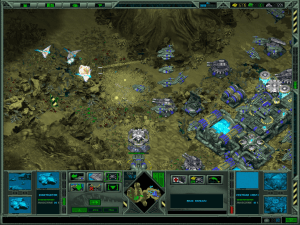














 5 MB (Windows)
5 MB (Windows)